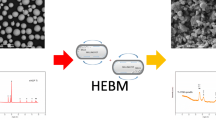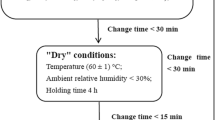Abstract
Titanium (Ti) metal was treated with water or HCl solutions after 5 M NaOH solution treatment and then subjected to heat treatment at 600°C. The apatite-forming abilities of the treated Ti metals were examined in simulated body fluid. The apatite-forming ability of the Ti metal subjected to NaOH, water and heat treatment was lower than that of just NaOH and heat treatments. Ti metals subjected to NaOH, HCl and heat treatment showed apatite-forming abilities, which increased with increasing HCl concentrations up to the same level as that of NaOH- and heat-treated Ti metal. The former did not show a decrease in its apatite-forming ability, even in a humid environment for a long period, whereas the latter decreased its ability. The increase in the apatite-forming ability with increasing HCl concentrations suggests a different mechanism of apatite formation from that previously proposed.











Similar content being viewed by others
References
Kim HM, Miyaji F, Kokubo T, Nakamura T. Preparation of bioactive Ti and its alloy via simple chemical surface treatment. J Biomed Mater Res. 1996;32:409–17. doi:10.1002/(SICI)1097-4636(199611)32:3<409::AID-JBM14>3.0.CO;2-B.
Nishiguchi S, Fujibayashi S, Kim HM, Kokubo T, Nakamura T. Biology of alkali- and heat-treated titanium implants. J Biomed Mater Res. 2003;67A:26–35.
Uchida M, Kim HM, Kokubo T, Fujibayashi S, Nakamura T. Effect of water treatment on the apatite-forming ability of NaOH-treated titanium metal. J Biomed Mater Res (Appl Biomater). 2002;63:522–30. doi:10.1002/jbm.10304.
Fujibayashi S, Nakamura T, Nishiguchi S, Tamura J, Uchida M, Kim HM, et al. Bioactive titanium: Effect of sodium removal on the bone-bonding ability of bioactive titanium prepared by alkali and heat treatment. J Biomed Mater Res. 2001;56:562–70. doi:10.1002/1097-4636(20010915)56:4<562::AID-JBM1128>3.0.CO;2-M.
Fujibayashi S, Neo M, Kim HM, Kokubo T, Nakamura T. Osteoinduction of porous bioactive titanium metal. Biomaterials. 2004;25:443–50. doi:10.1016/S0142-9612(03)00551-9.
Takemoto M, Fujibayashi S, Neo M, Suzuki J, Matsushita T, Kokubo T, et al. Osteoinductive porous titanium implants: Effect of sodium removal by dilute HCl treatment. Biomaterials. 2006;27:2682–91. doi:10.1016/j.biomaterials.2005.12.014.
Takemoto M, Fujibayashi S, Neo M, So K, Akiyama N, Matsushita T, et al. A porous bioactive titanium implant for spinal interbody fusion: an experimental study using a canine model. J Neurosurg Spine. 2007;7:435–43. doi:10.3171/spi.2007.7.4.435.
Bruijn JDD, Shankar K, Yuan H, Habibovic P. Osteoinduction and its evaluation. In: Kokubo T, editor. Bioceramics and their clinical applications. Cambridge: Woodhead Publishing Ltd.; 2008. p. 199.
Kokubo T, Takadama H. How useful is SBF in predicting in vivo bone bioactivity? Biomaterials. 2006;27:2907–15. doi:10.1016/j.biomaterials.2006.01.017.
Wang XX, Hayakawa S, Tsuru K, Osaka A. Bioactive titania gel layers formed by chemical treatment of Ti substrate with a H2O2/HCl solution. Biomaterials. 2002;23:1353–7. doi:10.1016/S0142-9612(01)00254-X.
Wang XX, Yan W, Hayakawa S, Tsuru K, Osaka A. Apatite deposition on thermally and anodically oxidized titanium surfaces in a simulated body fluid. Biomaterials. 2003;24:4631–7. doi:10.1016/S0142-9612(03)00357-0.
Uchida M, Kim HM, Kokubo T, Fujibashi S, Nakamura T. Structural dependence of apatite formation on titania gels in a simulated body fluid. J Biomed Mater Res. 2003;64A:164–70.
Yang B, Uchida M, Kim HM, Zhang X, Kokubo T. Preparation of bioactive titanium metal via anodic oxidation treatment. Biomaterials. 2004;25:1003–10. doi:10.1016/S0142-9612(03)00626-4.
Rohanizadeh R, Al-Sadeq M, LeGeros RZ. Preparation of different forms of titanium oxide on titanium surface: effects on apatite deposition. J Biomed Mater Res. 2004;71A:343–52. doi:10.1002/jbm.a.30171.
Wu JM, Hayakawa S, Tsuru K, Osaka A. Low-temperature preparation of anatase and rutile layers on titanium substrates and their ability to induce in vitro apatite deposition. J Am Ceram Soc. 2004;87:1635–42.
Zhao X, Liu X, Ding X,C. Acid induced bioactive titania surface. J Biomed Mater Res. 2005;75A:888–94. doi:10.1002/jbm.a.30485.
Lu X, Zhao Z, Leng Y. Biomimetic calcium phosphate coatings on nitric acid treated titanium surfaces. Mater Sci Eng C. 2007;27:700–8. doi:10.1016/j.msec.2006.06.030.
Lee MH, Park IS, Min KS, Ahn SG, Park JM, Song KY, et al. Evaluation of in vitro and in vivo tests for surface modified Titanium by H2SO4 and H2O2 treatment. Metals Mater Int. 2007;13:109–15.
Lu X, Wang Y, Yang X, Zhang Q, Zhao Z, Weng LT, et al. Spectroscopic analysis of titanium surface functional groups under various surface modification and their behaviors in vitro and in vivo. J Biomed Mater Res. 2008;84A:523–34. doi:10.1002/jbm.a.31471.
Zhao X, Liu X, You J, Chen Z, Ding C. Bioactivity and cytocompatibility of plasma-sprayed titania coating treated by sulfuric acid treatment. Surf Coat Technol. 2008;202:3221–6. doi:10.1016/j.surfcoat.2007.11.026.
Lindberg F, Heinrichs J, Ericson F, Thomsen P, Engqvist H. Hydroxylapatite growth on single-crystal rutile substrates. Biomaterials. 2008;29:3317–23. doi:10.1016/j.biomaterials.2008.04.034.
Sugino A, Ohtsuki C, Tsuru K, Hayakawa S, Nakano T, Okazaki Y, et al. Effect of spatial design and thermal oxidation on apatite formation on Ti–15Zr–4Ta–4Nb alloy. Acta Biomater. 2009;5:298–304. doi:10.1016/j.actbio.2008.07.014.
Sun X, Li Y. Synthesis and characterization of ion-exchangeable titanate nanotubes. Chem Eur J. 2003;9:2229–38. doi:10.1002/chem.200204394.
Tsai CC, Teng H. Structural features of nanotubes synthesized from NaOH treatment on TiO2 with different post-treatments. Chem Mater. 2006;18:367–73. doi:10.1021/cm0518527.
Kim HM, Himeno T, Kawashita M, Lee JH, Kokubo T, Nakamura T. Surface potential change in bioactive titanium metal during the process of apatite formation in simulated body fluid. J Biomed Mater Res. 2003;67A:1305–9.
Takagi H, Kokubo T, Tashiro M. Alkaline durability of Na2O–BaO–Al2O3–TiO2 glasses. J Ceram Assoc Jpn. 1981;89:418–26.
Kokubo T, Takagi H, Tashiro M. Alkaline durability of BaO–TiO2–SiO2 glasses. J Non-Cryst Solids. 1982;52:427–33.
Author information
Authors and Affiliations
Corresponding author
Rights and permissions
About this article
Cite this article
Pattanayak, D.K., Kawai, T., Matsushita, T. et al. Effect of HCl concentrations on apatite-forming ability of NaOH–HCl- and heat-treated titanium metal. J Mater Sci: Mater Med 20, 2401–2411 (2009). https://doi.org/10.1007/s10856-009-3815-0
Received:
Accepted:
Published:
Issue Date:
DOI: https://doi.org/10.1007/s10856-009-3815-0




